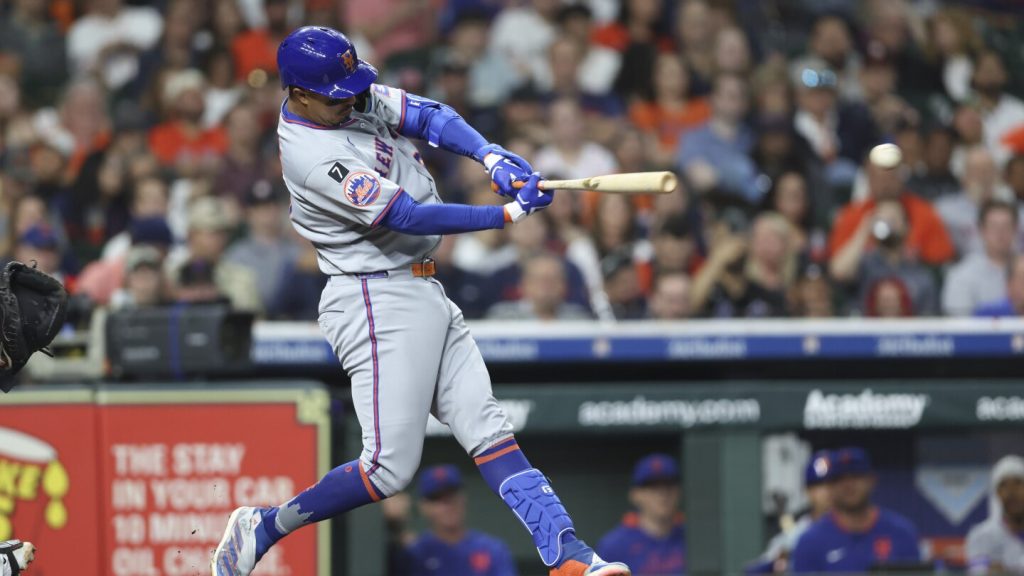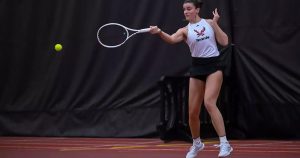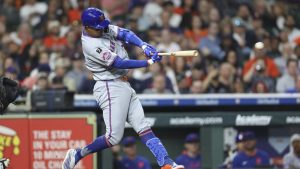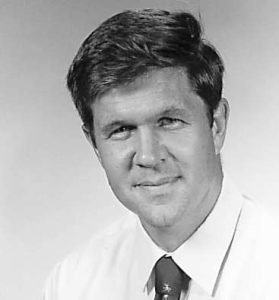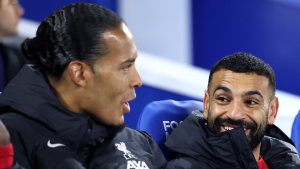The Mets made their lineup instantly more dangerous this off-season when they signed Juan Soto to a historic $756 million deal and then further solidified it by bringing back first baseman Pete Alonso on a two-year deal. However, the lineup being as deep and consistent as the team needed it to be to win a title depended on the development of young homegrown prospects like Mark Vientos and Brett Baty.
Just 11 games into the season, those two have not hit the ground running the way many hoped they would. After a white hot spring training that led him to win the vacant second base job, Baty came into Wednesday’s game against the Marlins, slashing just .125/.125/.167 in 24 plate appearances with one extra base hit, no walks, and nine strikeouts. Meanwhile, Vientos, who has started every game, came into Wednesday hitting .125/.239/.175 with two doubles, two runs scored, and one RBI.
The Mets are off to a strong start as a team, so the sluggishness can be excused. However, as the boo’s rained down from the crowd during Wednesday’s loss to the Marlins, it became clear that a few more losses and the team may have to answer questions about not seeing results on the field from their young hitters.
“You know, that’s baseball,” said Mets manager Carlos Mendoza. “At times, it’s not going to go your way, even when you’re doing a lot of things right. But understanding that you’ve got a long way to go, we’ve got a lot of baseball games left here, and you just can’t get caught up reacting to not having results.”
That’s especially true when the process is exactly what the player and the team want, which seems to be the case for Vientos in the early going.
Despite the surface-level results not being there, Vientos is chasing fewer pitches outside of the zone, making more contact overall, and sporting a zone contact rate that is 8% better than his career average and right in line with the MLB average zone contact rate.
“Swing rate is down, contact is up. I think that’s a good thing, sounds like,” smiled Vientos before Wednesday’s game. “I’m putting balls in play, and I’m just not getting lucky right now. It’s just sticking to that process and having good at-bats, and eventually it’s gonna come my way.”
One issue could be that Vientos may be out in front too much early on. His pull rate is up near 52%, which is well above his 39.6% career mark, and his overall hard contact numbers are a bit under where we normally see them. That could be connected to seeing more breaking balls this year, with pitches attacking him with breakers 47.4% of the time, up from 40% last year. Although Vientos doesn’t seem to think that’s playing into it much.
“I feel like I’ve always been pitched off speed and not really getting that many fastballs to hit in the game,” he said. It just comes down to doing damage on the fastballs he does get. So far, the 25-year-old hasn’t been doing that, hitting just .095 against fastballs and doing significantly less damage on pitches in the heart of the strike zone than he has historically.
However, that can be forgiven for a while because Vientos is continuing to get himself into counts where he gets opportunities to see pitches he can drive. “I feel like I’ve been swinging at what I want to swing at,” he explained.” Which is, in part, due to laying off pitches he doesn’t feel like he can drive and getting himself into hitter’s counts. That type of patience can be a fine line for hitters to walk, as it can frequently become passivity and letting too many good pitches go by. The Mets and Vientos don’t believe that’s the case in the early going.
“I think being too passive is probably taking too many pitches that I know I could square up,” said Vientos. “I don’t think I’ve had too many of those.” It’s a sentiment that his manager shares. “I know you want to see results,” Mendoza commiserated, “but controlling the strike zone, hitting the ball hard, getting good pitches, not chasing. What else can you ask?”
In truth, the Mets can’t ask for much more in terms of approach than Vientos is giving them. They simply need him to make meaningful contact on pitches in locations and counts where he has historically had plenty of success. You’d have to figure the big hits are going to come.
“You’re doing the things that you should be doing, controlling the things you can control,” explained Mendoza. “That’s part of the adjustment in becoming an established big league player, where, ‘Hey man, I’m doing everything right but I’m not getting results.’ Stay the course.”
While the answer for Vientos’ struggles may simply be time and patience, the response for Baty is not so simple.
“He needs to dictate at bats,” said Mendoza. “[Pitchers are] getting ahead of him. They are attacking him. He’s not driving the ball early in counts. They’re making him chase.”
In his first nine starts of the season, Baty has a first pitch strike rate of 79%. That means that 79% of the time, he either takes a called strike on an 0-0 count or swings and misses/fouls one off to get into an 0-1 count. The MLB average so far in 2025 is 62%, so Baty is dangerous below-average there.
“He’s 0-2, 0-1, a lot,” confirmed Mendoza. “It’s not easy to hit [like that] at this level.”
In some sense, this has always been the version of Brett Baty we’ve seen at the MLB level. He has a 17.3% called strike rate this year, but has a 17.2% mark for his career – both are higher than the league average. He has been in a two-strike count 36.5% of the time this year and was in one 32.5% of the time last year, but the MLB average is 29.6%. When he has gotten into those two-strike counts, it has allowed pitchers to force him to chase their pitch. Baty has a PutAway rate of 23.7% this year, which means 23.7% of two-strike pitches to Baty have resulted in strikeouts. The MLB average is 20.2%.
“You’ve got to be ready for your pitches and do damage,” said Mendoza. “He’s got that ability to do it. You just got to go out there and do it.”
Unfortunately for Baty, the time he has to go out there and do that may be coming to an end with starting second baseman Jeff McNeil likely to start a rehab assignment this week.
The hope for the Mets is that Jeff McNeil will begin a rehab assignment later this week
Francisco Alvarez will begin one tomorrow in Port St. Lucie pic.twitter.com/OsI7PKIl7H
— SNY (@SNYtv) April 8, 2025
McNeil has been sidelined since spring training with an oblique injury but has been taking batting practice on the field and will now look to get his timing down in live at-bats. That may take about two weeks, but then McNeil will return to the active roster, and one of Brett Baty or Luisangel Acuna will need to be sent to Triple-A Syracuse. Considering Acuna is the better defender and would also be valuable for the Mets as a pinch runner, it seems that he would have the upper hand in a battle for the final roster spot.
Unless Brett Baty starts hitting.
That means the 25-year-old only has a couple more weeks to stop letting pitchers dictate the at-bat and start making them pay earlier in counts. If he can do that, and Vientos’ results start to match his process, this Mets lineup could be even more dangerous than we’ve already seen.
The Mets made their lineup instantly more dangerous this off-season when they signed Juan Soto to a historic $756 million deal and then further solidified it by bringing back first baseman Pete Alonso on a two-year deal. However, the lineup being as deep and consistent as the team needed it to be to win a title depended on the development of young homegrown prospects like Mark Vientos and Brett Baty.
Just 11 games into the season, those two have not hit the ground running the way many hoped they would. After a white hot spring training that led him to win the vacant second base job, Baty came into Wednesday’s game against the Marlins, slashing just .125/.125/.167 in 24 plate appearances with one extra base hit, no walks, and nine strikeouts. Meanwhile, Vientos, who has started every game, came into Wednesday hitting .125/.239/.175 with two doubles, two runs scored, and one RBI.
The Mets are off to a strong start as a team, so the sluggishness can be excused. However, as the boo’s rained down from the crowd during Wednesday’s loss to the Marlins, it became clear that a few more losses and the team may have to answer questions about not seeing results on the field from their young hitters.
“You know, that’s baseball,” said Mets manager Carlos Mendoza. “At times, it’s not going to go your way, even when you’re doing a lot of things right. But understanding that you’ve got a long way to go, we’ve got a lot of baseball games left here, and you just can’t get caught up reacting to not having results.”
That’s especially true when the process is exactly what the player and the team want, which seems to be the case for Vientos in the early going.
Despite the surface-level results not being there, Vientos is chasing fewer pitches outside of the zone, making more contact overall, and sporting a zone contact rate that is 8% better than his career average and right in line with the MLB average zone contact rate.
“Swing rate is down, contact is up. I think that’s a good thing, sounds like,” smiled Vientos before Wednesday’s game. “I’m putting balls in play, and I’m just not getting lucky right now. It’s just sticking to that process and having good at-bats, and eventually it’s gonna come my way.”
One issue could be that Vientos may be out in front too much early on. His pull rate is up near 52%, which is well above his 39.6% career mark, and his overall hard contact numbers are a bit under where we normally see them. That could be connected to seeing more breaking balls this year, with pitches attacking him with breakers 47.4% of the time, up from 40% last year. Although Vientos doesn’t seem to think that’s playing into it much.
“I feel like I’ve always been pitched off speed and not really getting that many fastballs to hit in the game,” he said. It just comes down to doing damage on the fastballs he does get. So far, the 25-year-old hasn’t been doing that, hitting just .095 against fastballs and doing significantly less damage on pitches in the heart of the strike zone than he has historically.
However, that can be forgiven for a while because Vientos is continuing to get himself into counts where he gets opportunities to see pitches he can drive. “I feel like I’ve been swinging at what I want to swing at,” he explained.” Which is, in part, due to laying off pitches he doesn’t feel like he can drive and getting himself into hitter’s counts. That type of patience can be a fine line for hitters to walk, as it can frequently become passivity and letting too many good pitches go by. The Mets and Vientos don’t believe that’s the case in the early going.
“I think being too passive is probably taking too many pitches that I know I could square up,” said Vientos. “I don’t think I’ve had too many of those.” It’s a sentiment that his manager shares. “I know you want to see results,” Mendoza commiserated, “but controlling the strike zone, hitting the ball hard, getting good pitches, not chasing. What else can you ask?”
In truth, the Mets can’t ask for much more in terms of approach than Vientos is giving them. They simply need him to make meaningful contact on pitches in locations and counts where he has historically had plenty of success. You’d have to figure the big hits are going to come.
“You’re doing the things that you should be doing, controlling the things you can control,” explained Mendoza. “That’s part of the adjustment in becoming an established big league player, where, ‘Hey man, I’m doing everything right but I’m not getting results.’ Stay the course.”
While the answer for Vientos’ struggles may simply be time and patience, the response for Baty is not so simple.
“He needs to dictate at bats,” said Mendoza. “[Pitchers are] getting ahead of him. They are attacking him. He’s not driving the ball early in counts. They’re making him chase.”
In his first nine starts of the season, Baty has a first pitch strike rate of 79%. That means that 79% of the time, he either takes a called strike on an 0-0 count or swings and misses/fouls one off to get into an 0-1 count. The MLB average so far in 2025 is 62%, so Baty is dangerous below-average there.
“He’s 0-2, 0-1, a lot,” confirmed Mendoza. “It’s not easy to hit [like that] at this level.”
In some sense, this has always been the version of Brett Baty we’ve seen at the MLB level. He has a 17.3% called strike rate this year, but has a 17.2% mark for his career – both are higher than the league average. He has been in a two-strike count 36.5% of the time this year and was in one 32.5% of the time last year, but the MLB average is 29.6%. When he has gotten into those two-strike counts, it has allowed pitchers to force him to chase their pitch. Baty has a PutAway rate of 23.7% this year, which means 23.7% of two-strike pitches to Baty have resulted in strikeouts. The MLB average is 20.2%.
“You’ve got to be ready for your pitches and do damage,” said Mendoza. “He’s got that ability to do it. You just got to go out there and do it.”
Unfortunately for Baty, the time he has to go out there and do that may be coming to an end with starting second baseman Jeff McNeil likely to start a rehab assignment this week.
McNeil has been sidelined since spring training with an oblique injury but has been taking batting practice on the field and will now look to get his timing down in live at-bats. That may take about two weeks, but then McNeil will return to the active roster, and one of Brett Baty or Luisangel Acuna will need to be sent to Triple-A Syracuse. Considering Acuna is the better defender and would also be valuable for the Mets as a pinch runner, it seems that he would have the upper hand in a battle for the final roster spot.
Unless Brett Baty starts hitting.
That means the 25-year-old only has a couple more weeks to stop letting pitchers dictate the at-bat and start making them pay earlier in counts. If he can do that, and Vientos’ results start to match his process, this Mets lineup could be even more dangerous than we’ve already seen.
